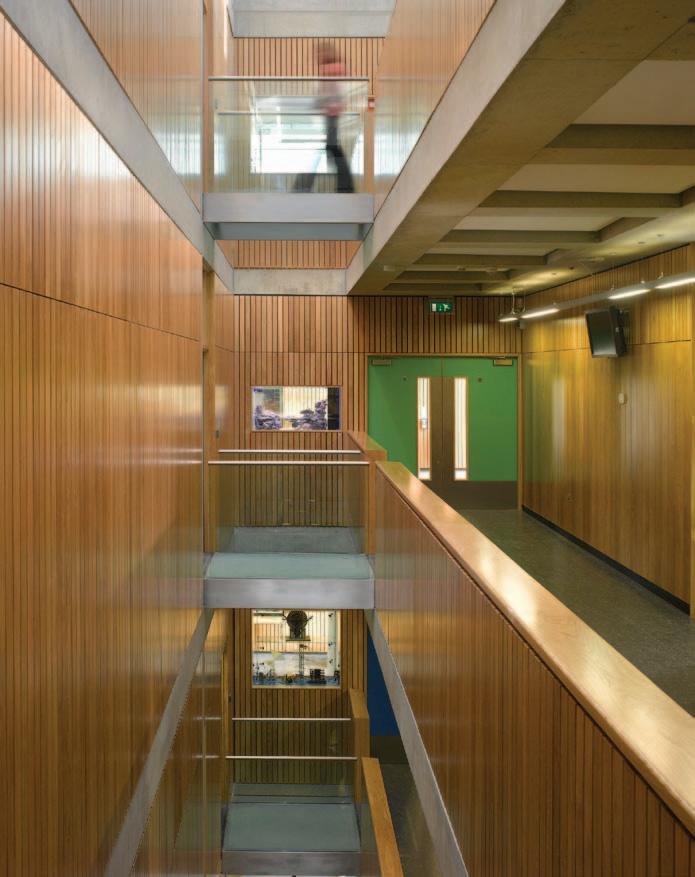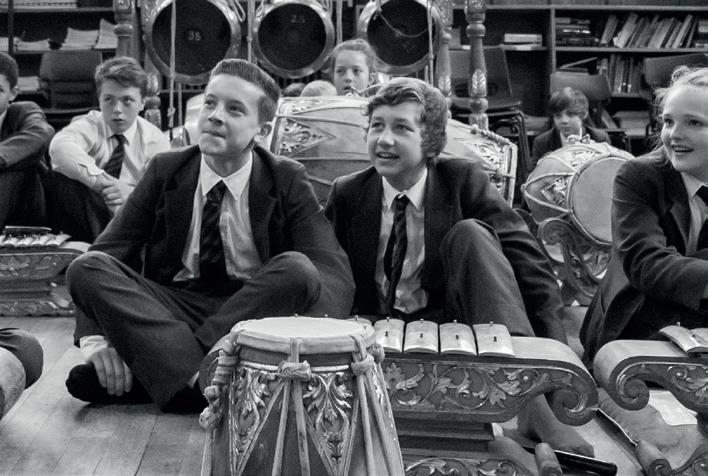
5 minute read
Classrooms of the future, Meryl Townley
Classrooms of the future Meryl Townley describes how independent schools are leading the way in STEM school design
As technology evolves, so does society, and curriculum and pedagogy with it. Digital and scientific advancement is progressing at an astounding rate, and our children have educational needs and expectations never encountered before. Students no longer expect or desire to be passive observers, preferring instead to be fully involved, integrated and connected. Their surroundings, therefore, must also be integrated. This rapid change requires a unique response, an inventive modernisation of the traditional ‘classroom plus specialist space’ format.
Pupils of STEM subjects require the physical ability to link to and connect with the spaces they work and learn in. Wireless/ digital/integrated tech are therefore key considerations when designing STEM facilities, and the way in which these elements are combined with analytical space planning is integral to how a building can have a lasting impact. Inspired children will go on to become the next generation of innovators in a global market, so preparing them for the modern competitive workplace is crucial. Work environments are changing too: problem solving in groups is used by leading companies to create a community of learning, opening up shared information streams; whilst open collaborative areas, especially between disciplines, foster a critical cross-pollination of ideas.
Crucially, the majority of teaching is dictated by the syllabus and this does not allow much scope for overlap between
departments. Collaborative learning, therefore, mainly happens through Project Work or Extended Project Qualification. Although many schools are striving to encourage more of this type of learning, there is no specific hub for this type of activity. This is in part why STEM buildings can become such great assets to schools, as they provide a unique, dedicated space for cross-curriculum teaching and project-based learning.
An award-winning design-led practice, van Heyningen and Haward Architects (vHH) has over 35 years of specialist experience in the Education sector. As the national curriculum and pedagogic approaches have developed, it has become more and more evident that an essential element of the design of a STEM building is recognising that the circulation, social and foyer spaces, and congenial outside spaces, are key for crossfertilisation and informal learning. These shared, informal, social spaces are where conversations and debate take place, ideas are sparked and participation encouraged. The nontechnical spaces are just as important for learning and the sharing of ideas and allow the expensive technical spaces to be timetabled more heavily.
At Latymer Upper School, we were appointed in 2013 to build our third building for the school, a new Science and Library Building with 3 floors of labs and a ground floor library and resource centre. Their constrained campus meant that the full STEM approach was not available, and so the focus was
instead on creating high-spec specialist Science facilities as an independent faculty. However, the generous circulation areas are designed to provide places for those moments of interaction.
Since then we have delivered specialist Science and Technology buildings for a number of prestigious independent schools. Our projects at Luckley House and St Benedict’s School included both specialist labs and technology workshops as additional teaching space. Above all, our recently completed STEM facility for Oundle School, SciTec, shows the full potential of what a unified STEM approach can achieve. The STEM disciplines at Oundle had previously been disparate and independent, but with stand-out teaching from the Head of Science and Head of Design & Technology, the school was keen to provide more innovative facilities in which the staff and students could explore new technologies and ways of learning.
We always stress to clients that engagement of all stakeholders at an early stage in the briefing and design process is essential. The early engagement of staff and students allows the brief to be questioned and tested by the architect and the SMT so that everyone is clear about the aspirations, objectives and constraints of the project. This is particularly important for collaborative environments which involve several disciplines, and our STEM projects have really benefitted from an open and collaborative briefing process. We manage the process carefully with our clients, so that the ‘wish lists’ which are normal outcomes from the early engagement are refined into realistic and deliverable briefs.
At Oundle, this worked impeccably: each department had specific needs and it was crucial that they could give detailed feedback at the initial briefing stage of the project. We documented inputs and feedback, consolidating the information into a detailed brief – bespoke to SciTec – which then formed the foundation for the project’s success thereafter.

A key concern for our clients is how they can future-proof their buildings, and our advice in the first instance is to design spaces that are flexible enough to allow for that space to adapt with new technologies. At Oundle, we focused on integration – of discipline, students, and technology. All four STEM subjects were brought together under one department, with the highestspec specialist facilities and with cross-curricular learning in mind. This approach has led to Oundle being described by School House Magazine online as one of ‘the best schools for STEM subjects’, and the school’s view is equally positive. As the Head, Mrs Sarah Kerr-Dineen, commented, ‘SciTec has been an extraordinary success. Its architecture appeals to all who encounter it, especially young people, and the physical alliance of intellectually cognate subjects is inspiring exciting developments. The team at vHH understood the vision and worked brilliantly with the School in bringing it to life.’
As architects we strongly believe in the ethos of STEM learning and its importance, and have witnessed first-hand the benefits of building this type of facility in schools. Creating dedicated spaces for innovation and focusing on the concept of cross-fertilisation within school subjects is incredibly interesting. We are excited by the future it holds for teaching, learning – and architecture. We are currently working at Ardingly College, where we are remodelling the existing science and DT departments, using a mixture of intelligent refurbishment and extension, to create an integrated STEM facility that will be more than the sum of its parts. Meryl Townley is a partner at van Heyningen and Haward Architects Artwork designed by Draisci Studio / www.draisci.com Photography by Will Scott

ONE SOLUTION INFINITE POSSIBILITIES FOR YOUR SCHOOL SUPPORT
PASTORAL CARE NEEDS


DRIVE EFFICIENCY

ATTRACT NEW PUPILS



RAISE ACHIEVEMENT

ACCESSIBLE
DATA FOR EVERY ROLE












